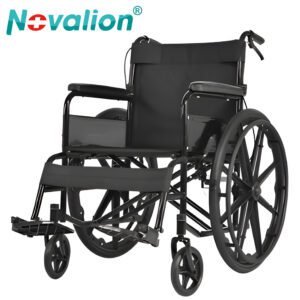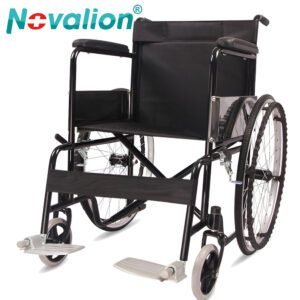Adjustable Wheelchair: A Guide to Customizable Mobility Solutions
For individuals with changing mobility needs or unique physical requirements, a one-size-fits-all wheelchair often falls short. An adjustable wheelchair solves this by offering customizable features that adapt to the user’s body, preferences, and daily activities. This guide answers all key questions about adjustable wheelchairs, from their design to how to choose, use, and maintain one.
What is an adjustable wheelchair?
An adjustable wheelchair is a mobility device with multiple customizable components that can be modified to fit the user’s specific needs. Unlike fixed-frame wheelchairs, which have static dimensions, these models allow adjustments to critical features like seat width, height, depth, backrest angle, and armrest/footrest position. The adjustments are typically made using levers, knobs, or quick-release mechanisms, enabling users or caregivers to modify the chair without tools. This flexibility ensures the wheelchair can adapt as the user’s needs change—whether due to growth (in pediatric users), recovery from injury, or shifts in comfort preferences.
How does it differ from a fixed-frame wheelchair?
The key distinction lies in adaptability, which impacts long-term usability:
- Custom fit: Fixed-frame wheelchairs come in standard sizes (e.g., 16–20 inch seat widths) that may not align with the user’s body, leading to discomfort or pressure points. Adjustable wheelchairs let users tweak dimensions (e.g., narrowing the seat by 2 inches or raising the seat height) for a precise fit.
- Adaptability to changing needs: A fixed-frame chair becomes obsolete if the user’s mobility declines, grows (in children), or requires new support (e.g., a higher backrest after surgery). Adjustable models can be reconfigured—saving the cost of buying a new chair.
- Versatility across activities: Whether navigating tight indoor spaces (needing a narrower width) or outdoor terrain (requiring higher ground clearance), adjustable wheelchairs can be modified for each scenario. Fixed-frame chairs lack this flexibility.
Who can benefit from an adjustable wheelchair?
- Pediatric users: Children with mobility needs, as adjustable features (e.g., seat depth, backrest height) can grow with them, avoiding the need for frequent replacements.
- Users in recovery: Individuals recovering from surgeries or injuries, where changing comfort needs (e.g., a reclined backrest post-op) require temporary adjustments.
- People with variable mobility: Those with conditions like multiple sclerosis or arthritis, where pain levels or strength fluctuate, needing daily tweaks to seat angle or armrest height.
- Care facilities: Nursing homes or rehab centers, where a single adjustable wheelchair can serve multiple residents with different needs, reducing equipment costs.
What adjustable features should you prioritize?
- Dimensiones del asiento: Look for seat width (16–24 inches) and depth (16–20 inches) adjustments to match the user’s hip width and leg length. A seat that’s too narrow causes pressure; too wide reduces stability.
- Backrest angle and height: The backrest should recline (90–160 degrees) to reduce pressure on the lower back and allow rest. Height adjustments (16–22 inches) ensure support for the entire torso, critical for users with poor posture.
- Armrests and footrests: Armrests should adjust in height (6–10 inches) to support the elbows without straining the shoulders. Footrests need length and angle adjustments to keep the legs aligned, preventing knee or ankle strain.
- Frame height: Some models let you adjust the distance between the seat and ground (18–22 inches). A lower height eases transfers (e.g., to a bed), while a higher height improves visibility and ground clearance outdoors.
How to use an adjustable wheelchair safely?
- Proper adjustment protocol: Always adjust the chair while the user is not seated to avoid pinching or instability. Follow the manufacturer’s guidelines for each feature—over-tightening knobs can damage the mechanism.
- Stability checks post-adjustment: After modifying dimensions, test the wheelchair by gently pushing on the seat and backrest. Ensure all parts lock securely; wobbling indicates a loose adjustment.
- Avoid over-adjusting: Each feature has a safe range—exceeding it (e.g., reclining the backrest beyond 160 degrees) can tip the chair. Stick to the manufacturer’s limits.
- Document settings: Keep a record of optimal adjustments (e.g., “seat width 18 inches, backrest height 20 inches”) to quickly reset the chair if settings are changed by others.
¿Qué mantenimiento requiere?
- Adjustment mechanism care: Clean levers, knobs, and hinges weekly with a dry cloth to remove dirt, which can jam the mechanisms. Lubricate moving parts (e.g., recline hinges) monthly with silicone spray to keep adjustments smooth.
- Locking system checks: Test locks for each adjustable feature monthly. If a lock slips (e.g., the backrest slowly reclines), tighten the mechanism or replace worn parts—unexpected shifts endanger the user.
- Frame and upholstery: Wipe the frame with a damp cloth to prevent rust. For adjustable seats with fabric upholstery, clean spills promptly to avoid staining and maintain hygiene.
Are electric wheelchairs adjustable?
Yes, many electric wheelchairs offer adjustable features, though they’re often more limited than manual models due to motor and battery components. Electric versions typically allow seat height, backrest angle, and footrest adjustments, with some high-end models adding armrest and seat width tweaks. They’re ideal for users who need power propulsion y customization, such as those with limited strength but variable comfort needs.
An adjustable wheelchair is an investment in long-term mobility, adapting to the user’s body and lifestyle rather than forcing them to adapt to the chair. By prioritizing key adjustable features and using them safely, users can enjoy comfort, stability, and independence for years.
Gracias por leer esto, querida. Si tiene alguna sugerencia sobre nuestro sitio web o quiere saber sobre la silla de ruedas, por favor Contacto. Le responderemos rápidamente.



